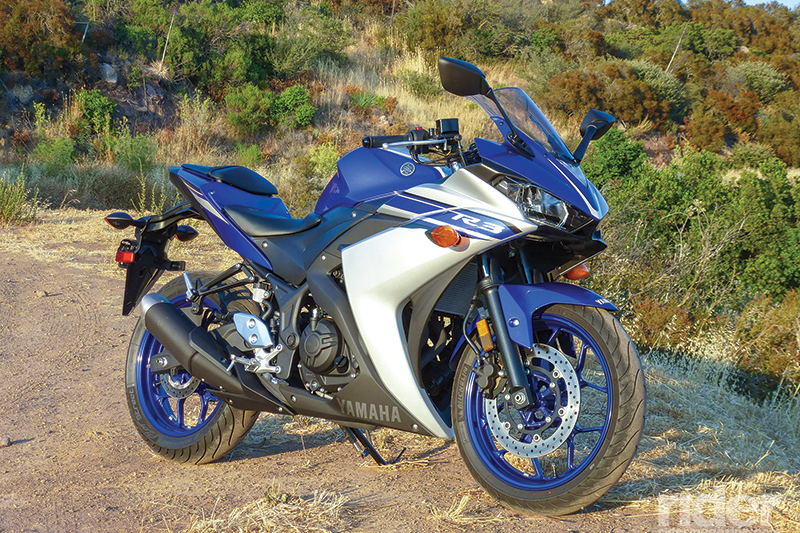2016 Yamaha YZF-R3

Rider Tour Test
From cliffs high above the Pacific Ocean to the salty mist near the water’s edge, California’s Route 1 along the Big Sur coast seduces two-wheeled travelers with sensuous curves in a stunning setting. If you’re lucky enough to enjoy the road without traffic, the experience is guaranteed a top spot on your best rides list. I rode it on a mid-summer getaway to Big Sur with two friends from my high school days, Steve Luick and Alan McKay. Curious to try touring on a smaller bike, I chose Yamaha’s sporty 321cc DOHC parallel twin, the YZF-R3. Introduced in 2015, the Yamaha was late to the 300cc sportbike scene, but came out charging at its street/track debut (Rider, July 2015, and on ridermagazine.com). How would it do with a little touring action?
With Chase Harper bags carefully fitted to the Yamaha’s pointy rear and the single rear shock’s preload cranked up (the only suspension adjustment available), the R3 was ready to travel. More than 100 miles of four-lane freeway between home and Route 1 gave me a chance to test its traveling comfort and ability to hang with traffic. The R3 cruises at typical over-the-limit California freeway speeds without breathing hard, its counterbalancer keeping things relaxed at the seat, bars and pegs. Though some vibration creeps in at various rpm, I never found it annoying. Winding the fuel-injected 321cc up toward its 12,245 rpm redline is at least half the fun of riding the R3, assisted by a throttle pulley that progressively magnifies grip twist at the dual 32mm throttle bodies. The motor has enough low-end torque not to embarrass itself, but the experience I’ll remember is hitting 11 grand in third or fourth before shifting up.
Cambria was our first stop. We picked up Alan, who’d ridden his BMW F 800 GS down from Santa Cruz the night before. It was good to unwind from the R3, though I’d made those first 130 miles pain-free. The seating position is sporty but mild, with top-mounted clip-on handlebars, moderately rearset pegs and a comfortable, 30.7-inch-high seat that tapers for easy ground control. My 68-inch frame was right at home and my rear wasn’t complaining. Neither was my upper body—the R3’s small windscreen keeps buffeting to a minimum, and directs enough clean air at my chest to reduce the weight on my hands. The compact instrument pod has an accurate speedometer (1 mph error), a digital tach and a conservative fuel gauge with a low fuel indicator.
Joining an endless line of cars slogging north, we had no choice but to enjoy the scenery, which, as it turns out, is much better when not blurred by speed. The R3 putted along without overheating or cooking my legs. Needing a kick while in the doldrums, I’d drop back a ways, snick down a gear or two, then wind it out to the next gear (yes, I’m easily entertained). Finally settled into a cabin at Ripplewood Resort in Big Sur, we spent the warm afternoon talking of motorcycles past, present and future. The next morning Steve and I followed Alan north to Carmel as he headed home along more beautiful coastline. Returning south, we hit howling wind at Point Sur. The R3 stayed with traffic into the headwind, but crosswinds were difficult to manage on the 371-pound, fully gassed motorcycle.
The following day was my birthday, and quite a gift was waiting for me as we headed south before breakfast—a nearly empty road. This is where the R3 showed its mettle. Agile as a cheetah, the Yamaha swaps directions effortlessly on its attractive 17-inch cast aluminum wheels. Acceleration is a wrist twist away, and the clutch and tranny are a smooth team. Michelin Pilot Street tires dish up plenty of traction, but when pushing the bike, limits to the brakes and suspension become obvious. The Yamaha needs more braking power than the single discs offer; they’re not horrible, but the bike attains speeds that require excellent brakes, and these aren’t. The KYB inverted fork is spongy, with weak rebound damping letting the front-end recoil too fast from impacts. The single rear shock performs better, keeping the power and rider on the ground. These are weaknesses, though, not deal-breakers. The R3 is a hoot on a smooth road, and fine on rougher tarmac once you know its limits. Needless to say, we made quick work of getting home.
Sporty good looks aside, the YZF-R3 is a comfortable, exciting machine for any kind of pavement work. In 1,000 miles on this bike, I don’t think the smile ever left my face—well, maybe on that slow slog north. The miserly twin returned 54.2 mpg overall, burning 87 octane gasoline at an 11.2:1 compression ratio. With its 3.7-gallon tank and incredible 26,600-mile valve adjustment interval, touring is certainly an option—and a fun one at that.
